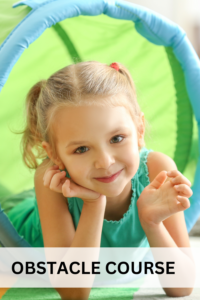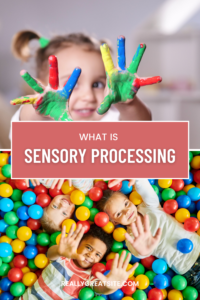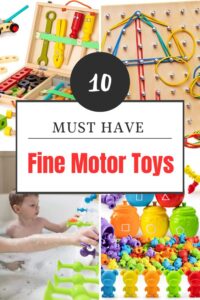
How Obstacle Courses Drive Cognitive, Physical, and Emotional Development in Kids
Learn how obstacle courses help develop cognitive, physical, and emotional skills in kids. Find out what benefits an obstacle course can bring to your child’s development and how to create and implement your own obstacle course for the best results. T
This post was created by Marra Robert, OTD, OTRL and contains affiliate links.

Obstacle courses are truly AMAZING! They have always been a beloved activity of children. They have fun conquering the obstacles that cross their paths and find victory when they overcome them.
You’ll see their faces turn from focus to pure joy. It’s fun just to watch a child move through an obstacle course. But did you know that this fun activity is full of excellent benefits for children?
Obstacle courses profoundly impact their development, including their cognitive skills, sensory processing, and motor skills, as well as aspects of their mental health, including their self-esteem, grit, and resilience.
In this article will examine all of the amazing benefits that obstacle courses can have on your child’s development, as well as how to build a fun and engaging obstacle course at home.
Hi! My name is Marra, and I am a mama and a pediatric occupational therapist. I’ve spent years working with children and their families, helping them navigate all kinds of developmental challenges.
Whether I was working with a toddler with sensory processing challenges, a 5-year-old with autism, a 10-year-old with Down Syndrome, or a teenager with sensory concerns and decreased self-confidence, obstacle courses would always be in my treatment toolbox.
Obstacle courses are also incredibly beneficial for children without developmental challenges. My daughter just had her 2nd birthday, and we’ve started working on obstacle courses.
She is neurotypical, and I can already see the benefits for her. She loves it so much that she is now requesting it after she comes home from daycare.
This post is all about obstacle courses and how they can boost cognitive, physical, and emotional development in kids.
Obstacle Courses and Sensory Processing
Obstacle courses are an incredibly powerful tool for a child’s development of their sensory processing system. Sensory processing is our ability to take in all of the information in our environment through our 8 senses, try to make sense of it, figure out what is important to pay attention to, and then choose an appropriate response.
If you would like to learn more about sensory processing, check out. What is Sensory Processing?

Some children have difficulty processing sensory input, which can impact their behaviors and emotions, making it more challenging to participate in the activities they enjoy.
If you have concerns about your child’s sensory processing skills, I’d recommend talking with a pediatric occupational therapist specializing in sensory processing. You can also learn more about the Sensory Red Flags You Might be Missing.
Back to obstacle courses, how can an obstacle course help with sensory processing? When a child is navigating through an obstacle course, they receive a variety of sensory input: movement, deep, pressure, tactile, visual, and sometimes more in a structured way.
In order to successfully complete the obstacle course, they have to process and integrate different sensory input from different sensory systems, which is needed to strengthen skills such as balance, postural control, core strength, and body awareness.

Children must successfully integrate all of the sensory input to know how and where to move their bodies. This challenge strengthens their sensory processing skills.
When a child is provided with sensory input in a structured and organized way, it helps to regulate and calm their nervous system. As an added bonus, if you change the sequence or obstacles in the course every time, it’ll challenge their sensory processing skills in a new way.
OBSTACLE COURSES BOOST GROSS MOTOR AND FINE MOTOR DEVELOPMENT
ross motor skills are our big movements, such as running, jumping, balancing, and strength. Fine motor skills are required for the smaller movements we do with our hands, such as manipulating objects, cooking, using scissors, buttoning and unbuttoning, and handwriting.
So, you might be thinking that it’s clear how obstacle courses can benefit a child’s gross motor development. It challenges their balance, strength, coordination, motor planning, and body awareness. But how do fine motor skills strengthen fine motor development? That might not be as clear and straightforward.
Well, it’s first essential to understand that everything in our bodies are connected. You can’t separate out gross motor and fine motor skills. They are connected because the bigger muscles in our body support the smaller muscles in our body.
Children develop proximal to distal, or from the center of their body, the core, out to their fingers and toes. Therefore a baby needs to learn how to sit independently before they can use a spoon. It’s all connected.
The core supports our hips and shoulder muscles, our shoulders support our arm muscles, and our arms support the small muscles in our hands and fingers. We can strengthen their fine motor skills by strengthening the big muscles in a child’s body.
Another way you can use the obstacle course to strengthen a child’s fine motor skills is to add a fine motor activity to the course. An example would be to have them write 2 letters before going on the balance beam or find the bead in the theraputty before jumping on the trampoline.

Many of the children I saw for OT would have buttoning and unbuttoning goals, but we had a huge motivation issue. What child wants to sit down and practice buttoning over and over again?
I’ve never met any who do. I would place the button board or the shirt at a point in the obstacle course and they would have to unbutton or button 3 buttons before moving on. They were having so much fun in the obstacle course I don’t think they even realized they were practicing buttoning.
OBSTACLE COURSES CAN HELP WITH HOMEWORK
Does your child want to do their homework as soon as they get home from school? NO! Of course they don’t. They want and need to MOVE THEIR BODIES!!! Solution? Obstacle course!
Set up the obstacle course that leads to a chair and table. Every time they complete a certain number of questions, they get to move through the obstacle course.
They get to move their body and complete their homework. Plus, movement increases attention and helps them process the information. It’s a win-win!

OBSTACLE COURSES ENHANCE COGNITIVE DEVELOPMENT
Boosting problem-solving skills is a great way for obstacle courses to enhance children’s cognitive development. By navigating through various challenges and obstacles, children are constantly faced with problems that they need to solve to progress through the course.
The dynamic nature of obstacle courses requires children to think on their feet and come up with creative solutions in real time. Each obstacle presents a unique problem that demands quick thinking and strategic planning.
Whether it’s figuring out the best way to climb over something or finding the balance to traverse a narrow beam, children are constantly engaged in the process of problem-solving.
Children gradually develop a toolkit of problem-solving strategies by repeatedly tackling different obstacles. They learn to analyze the situation, break down complex problems into smaller, more manageable parts, and formulate a step-by-step approach to overcome challenges.
This process of trial and error helps children refine their problem-solving skills and build resilience in the face of setbacks. Repetition is key. Changing up the obstacle course is great because you provide the child with new challenges every time you change it. Have them master the obstacle several times before switching it up
OBSTACLE COURSES BOOST MEMORY AND ATTENTION
Memory and attention are 2 cognitive skills that are not only required for academic skills but also for most of the activities a child does, such as social skills and daily living tasks.
Obstacle courses can also improve these areas. As a child moves through an obstacle course, they have to remember the sequence, where to go next, and maybe even how they succeeded in that obstacle course the time before.
Mastering each obstacle in the course requires the child’s full attention, strengthening that skills. As they move through the obstacle course, they are moving their bodies and receiving so much great sensory input.
This helps to organize their nervous system and increase attention. Obstacle courses are really fun, and children are motivated to accomplish them. We know that our attention is so much stronger when we are participating in activities we are motivated by.
OBSTACLE COURSES FOSTER A LOVE FOR LEARNING
Obstacle courses are a great way to foster a love for learning in children. As I mentioned previously, every time your child participates in an obstacle course, you can switch up the activities and the sequence. I
t then becomes a new challenge that the child must master, and they become excited about that. It is such a gift to be excited by new challenges and the possibility of overcoming them. This love of learning can transfer to other areas of their lives.
Obstacle courses also instill a sense of curiosity and excitement in children, igniting their passion for learning. As they conquer each obstacle, they experience a sense of accomplishment and confidence that can carry over into their academic endeavors.
By fostering a love for learning in children through obstacle courses, we are setting them up for success in their academic journey.
With a strong foundation of cognitive skills, heightened focus, and a passion for learning, children are well-prepared to tackle any challenges that come their way.
As we continue to break boundaries in the field of education, let us not overlook the power of obstacle courses in shaping young minds and nurturing a lifelong thirst for knowledge and growth.,
OBSTACLE COURSES HELP DEVELOP GRIT AND RESILIANCE
The impact of obstacle courses on problem-solving skills extends beyond the gross motor and fine motor benefits. The lessons learned in the course easily transfer to other aspects of a child’s life, including academic endeavors and everyday problem-solving situations.
Through participating in an obstacle course and mastering it, a child learns that they can overcome challenges and difficult situations. This is one of the most important things a child can learn. It fosters the belief that I can do hard things, and if I try again and practice, I can do it.
The phrase “I can’t” is not allowed in my therapy sessions or at my house. I’ll say, “you are missing a word in that sentence.” “I can’t do it YET” is so much better.
Once a child develops grit and resilience, this transfers into all other aspects of their lives, and they are able to take on bigger challenges with confidence in their academic, social, family, and everyday lives.
Ok, now that we’ve covered all of the amazing benefits of obstacle courses and have learned how they foster a child’s physical, cognitive, and mental health, let’s take a look at who can participate in obstacle courses and how to set them up for your child appropriately.

The just right challenge
Who can participate in obstacle courses? The great thing about obstacle courses is that any child can participate in them regardless of age, physical, cognitive, or emotional developmental level.
It’s just about setting the obstacle course so the child is challenged and successful. In therapy, we call it the Just Right Challenge.
The Just Right Challenge is a balance between challenge and mastery. If we make an obstacle course way too easy for a child, they will not receive all of the amazing benefits discussed above.
It must be challenging and requires attention, strength, coordination, planning, and problem-solving. On the flip side, if it’s too hard and the child cannot succeed, they will be frustrated and not want to do it. It’s got to be the middle point, both challenging with the possibility of success. The Just Right Challenge.
WHERE AND WHEN TO START
I started doing obstacle courses with my daughter when she was 18 months old. However, it was challenging, and she wasn’t really interested. Now that she’s 2 years old, she LOVES Them. Funny story, but as I was writing this post yesterday,
I got a notification on my phone from my daycare app. I kid you not, they had sent me a video of her participating in an obstacle course. She was doing an obstacle course at the exact same time I was writing about obstacle courses. And she dominated it! I was one proud momma!
So any child can participate in an obstacle course regardless of their abilities. It’s all about finding the Just Right Challenge. When starting to work on obstacle courses with a child, I would have one obstacle and one activity.
An example of this is a puzzle and a tunnel. The child would get a puzzle piece, crawl through the tunnel, and put the puzzle piece in the puzzle at the other end of the tunnel. This simple obstacle course is a great way to start.
You can then build on from there, slowly adding one more step once your child has mastered it, always trying to find the just right challenge. Letting your child help you build the obstacle course and switch it up each time can be really fun.
This is also a great way to work on planning, sequencing, problem-solving, and creativity with an added sense of accomplishment and self-confidence boast.
Now that we’ve discussed all of the amazing benefits of an obstacle course and how to design one. I wanted to share some of my favorite tools that I love to use for setting up an obstacle course.
That being said, I used to have therapy sessions in the child’s home and have built some pretty amazing obstacle courses from only furniture and items I found in the home. So, you can absolutely start building obstacle courses from what you have in your house. This list is just some ideas for you.
TOOLS AND ACTIVITIES TO USE IN YOUR CHILD'S OBSTACLE COURSES
- Walking over couch cushions
- Climbing up on the couch and jumping down
- Crawling through a tunnel
- Stepping stones
- Balance beams
- Hopping on one foot
- Hopscotch
- Riding on the scooter board
- Slide
- Jumping on a trampoline
- Wall push-ups: Have your child stand arm’s length from the wall with their palms on the wall, lean while bending their elbows until their nose touches the wall, and then push off of the wall until their arms are straight.
- Chair or regular push ups
- Gym Playset for Children
- Ball pit
- Jumping on one foot
- Yoga: You can use these cards I have linked here, or you can make up your own yoga poses with your child.
- Exercises with theraband
- Theraputy
- Pushing a heavy laundry basket full of laundry or toys
- Animal walks
- Jumping on a crash pad or cushions
- Sit and spin
I hope you and your child have the best time creating amazing obstacle courses. Please let me know how it goes in the comments below.
